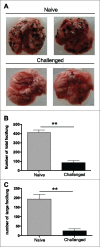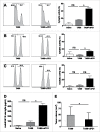PD-1 blockade at the time of tumor escape potentiates the immune-mediated antitumor effects of a melanoma-targeting monoclonal antibody
- PMID: 29123966
- PMCID: PMC5665071
- DOI: 10.1080/2162402X.2017.1353857
PD-1 blockade at the time of tumor escape potentiates the immune-mediated antitumor effects of a melanoma-targeting monoclonal antibody
Abstract
Tumor antigen-targeting monoclonal antibodies (TA-targeting mAbs) are used as therapeutics in many malignancies and their capacity to mobilize the host immunity puts them at the forefront of anti-cancer immunotherapies. Both innate and adaptive immune cells have been associated with the therapeutic activity of such antibodies, but tumor escape from mAb-induced tumor immune surveillance remains one of the main clinical issues. In this preclinical study, we grafted immunocompetent and immunocompromised mice with the B16F10 mouse melanoma cell line and treated them with the TA99 TA-targeting mAb to analyze the immune mechanisms associated with the tumor response and resistance to TA99 monotherapy. In immunocompetent mice TA99 treatment strongly increased the fraction of CD8 and CD4 effector T cells in the tumor compared with isotype control, highlighting the specific immune modulation of the tumor microenvironment by TA99. However, in most mice, TA99 immunotherapy could not prevent immune effector exhaustion and the recruitment of regulatory CD4 T cells and consequently tumor escape from immune surveillance. Remarkably, anti-PD-1 treatment at the time of tumor emergence restored the Th1 effector functions of CD4 and CD8 T cells as well as of natural killer and γδT cells, which translated into a significant slow-down of tumor progression and extended survival. Our findings provide the first evidence that PD-1 blockade at the time of tumor emergence can efficiently boost the host anti-tumor immune response initiated several weeks before by the TA-targeting mAb. These results are promising for the design of combined therapies to sensitize non-responder or resistant patients.
Keywords: anti-tumor immunity; combined therapies; immunomodulation; long-lasting effects; tumor escape; tumor immune microenvironment; tumor-targeting monoclonal antibodies.
Figures







Similar articles
-
Improved therapeutic efficacy of unmodified anti-tumor antibodies by immune checkpoint blockade and kinase targeted therapy in mouse models of melanoma.Oncotarget. 2021 Jan 19;12(2):66-80. doi: 10.18632/oncotarget.27868. eCollection 2021 Jan 19. Oncotarget. 2021. PMID: 33520112 Free PMC article.
-
Combined Trabectedin and anti-PD1 antibody produces a synergistic antitumor effect in a murine model of ovarian cancer.J Transl Med. 2015 Jul 29;13:247. doi: 10.1186/s12967-015-0613-y. J Transl Med. 2015. PMID: 26219551 Free PMC article.
-
Robust Antitumor Effects of Combined Anti-CD4-Depleting Antibody and Anti-PD-1/PD-L1 Immune Checkpoint Antibody Treatment in Mice.Cancer Immunol Res. 2015 Jun;3(6):631-40. doi: 10.1158/2326-6066.CIR-14-0190. Epub 2015 Feb 20. Cancer Immunol Res. 2015. PMID: 25711759
-
Tumor antigen-targeting monoclonal antibody-based immunotherapy: Orchestrating combined strategies for the development of long-term antitumor immunity.Oncoimmunology. 2014 Dec 13;3(9):e955684. doi: 10.4161/21624011.2014.955684. eCollection 2014 Oct. Oncoimmunology. 2014. PMID: 25941618 Free PMC article. Review.
-
CD8+ cytotoxic T lymphocytes in cancer immunotherapy: A review.J Cell Physiol. 2019 Jun;234(6):8509-8521. doi: 10.1002/jcp.27782. Epub 2018 Nov 22. J Cell Physiol. 2019. PMID: 30520029 Review.
Cited by
-
Improving Biologics' Effectiveness in Clinical Oncology: From the Combination of Two Monoclonal Antibodies to Oligoclonal Antibody Mixtures.Cancers (Basel). 2021 Sep 15;13(18):4620. doi: 10.3390/cancers13184620. Cancers (Basel). 2021. PMID: 34572847 Free PMC article. Review.
-
DHA-SBT-1214 Taxoid Nanoemulsion and Anti-PD-L1 Antibody Combination Therapy Enhances Antitumor Efficacy in a Syngeneic Pancreatic Adenocarcinoma Model.Mol Cancer Ther. 2019 Nov;18(11):1961-1972. doi: 10.1158/1535-7163.MCT-18-1046. Epub 2019 Aug 22. Mol Cancer Ther. 2019. PMID: 31439714 Free PMC article.
-
Tumor Cell-Based Vaccine Generated With High Hydrostatic Pressure Synergizes With Radiotherapy by Generating a Favorable Anti-tumor Immune Microenvironment.Front Oncol. 2019 Aug 28;9:805. doi: 10.3389/fonc.2019.00805. eCollection 2019. Front Oncol. 2019. PMID: 31555582 Free PMC article.
-
Improved therapeutic efficacy of unmodified anti-tumor antibodies by immune checkpoint blockade and kinase targeted therapy in mouse models of melanoma.Oncotarget. 2021 Jan 19;12(2):66-80. doi: 10.18632/oncotarget.27868. eCollection 2021 Jan 19. Oncotarget. 2021. PMID: 33520112 Free PMC article.
-
Novel Immunotherapeutic Approaches for Neuroblastoma and Malignant Melanoma.J Immunol Res. 2018 Oct 30;2018:8097398. doi: 10.1155/2018/8097398. eCollection 2018. J Immunol Res. 2018. PMID: 30510968 Free PMC article. Review.
References
-
- Sharma P, Allison JP. The future of immune checkpoint therapy. Science 2015; 348:56-61; PMID:25838373; https://doi.org/10.1126/science.aaa8172 - DOI - PubMed
-
- Apetoh L, Ghiringhelli F, Tesniere A, Obeid M, Ortiz C, Criollo A, Mignot G, Maiuri MC, Ullrich E, Saulnier P, et al.. Toll-like receptor 4-dependent contribution of the immune system to anticancer chemotherapy and radiotherapy. Nat Med 2007; 13:1050-9; PMID:17704786; https://doi.org/10.1038/nm1622 - DOI - PubMed
-
- Musolino A, Naldi N, Bortesi B, Pezzuolo D, Capelletti M, Missale G, Laccabue D, Zerbini A, Camisa R, Bisagni G, et al.. Immunoglobulin G fragment C receptor polymorphisms and clinical efficacy of trastuzumab-based therapy in patients with HER-2/neu-positive metastatic breast cancer. J Clin Oncol 2008; 26:1789-96; PMID:18347005; https://doi.org/10.1200/JCO.2007.14.8957 - DOI - PubMed
-
- Musolino A, Naldi N, Dieci MV, Zanoni D, Rimanti A, Boggiani D, Sgargi P, Generali DG, Piacentini F, Ambroggi M, et al.. Immunoglobulin G fragment C receptor polymorphisms and efficacy of preoperative chemotherapy plus trastuzumab and lapatinib in HER2-positive breast cancer. Pharmacogenomics J 2016; 16:472-7; PMID:27378608; https://doi.org/10.1038/tpj.2016.51 - DOI - PubMed
-
- Burkhardt B, Yavuz D, Zimmermann M, Schieferstein J, Kabickova E, Attarbaschi A, Lisfeld J, Reiter A, Makarova O, Worch J, et al.. Impact of Fc gamma-receptor polymorphisms on the response to rituximab treatment in children and adolescents with mature B cell lymphoma/leukemia. Ann Hematol 2016; 95:1503-12; PMID:27376362; https://doi.org/10.1007/s00277-016-2731-x - DOI - PubMed
Publication types
LinkOut - more resources
Full Text Sources
Other Literature Sources
Research Materials
